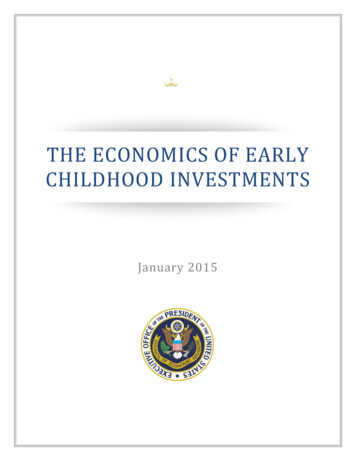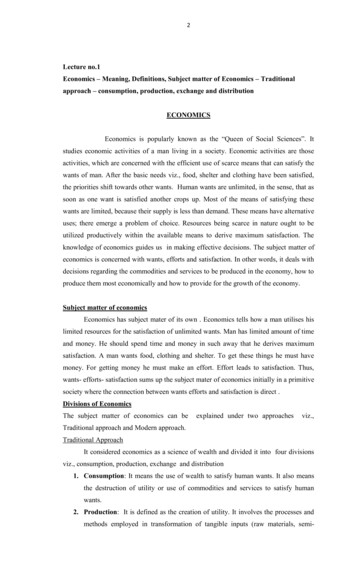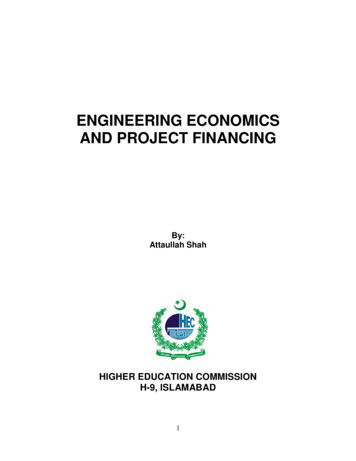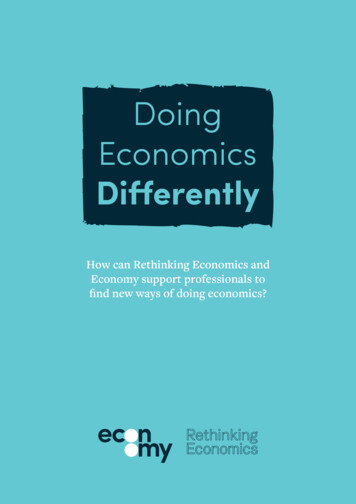
Transcription
THE ECONOMICS OF EARLYCHILDHOOD INVESTMENTSJanuary 2015
ContentsExecutive Summary. 2Introduction . 4I. Early Childhood Investments in the United States . 6Early Childhood Programs: From Home Visiting to Kindergarten . 6The Economics of Investing in Young Children . 7Benefits to Children . 7Benefits to Parents. 8Benefits to Society . 9Inequalities in Parental Time, Resources, and Education . 10Changes in Work and the Need for High-Quality Early Care and Education . 14II. The Impact Early Childhood Interventions on Children and Parents . 17The Effects of Early Childhood Programs for Very Young Children . 17Maternal Home Visiting . 17Early Care and Education Programs for Infants and Toddlers . 18The Effects of Early Care and Education Programs for Preschool-Aged Children . 20The “Active Ingredients” in Successful Early Childhood Programs . 25Curriculum. 26Program Duration . 26Teacher Quality and Professional Development . 27Parental Involvement and Quality of Out-of-School Time. 28Administration Proposals to Increase Investments in Early Education . 28III. Cost-Benefit Analysis of Preschool Programs . 31Estimating the Benefits of Spending on Early Childhood Programs . 32Early Childhood Education as a Long-Term Investment . 33Conclusion . 35References . 371
Executive SummaryEarly childhood, beginning in infancy, is a period of profound advances in reasoning, languageacquisition, and problem solving, and importantly, a child’s environment can dramaticallyinfluence the degree and pace of these advances. By supporting development when children arevery young, early childhood development and education programs can complement parentalinvestments and produce large benefits to children, parents, and society.An analysis by the President’s Council of Economic Advisers describes the economic returns toinvestments in childhood development and early education. Some of these benefits, such asincreases in parental earnings and employment, are realized immediately, while other benefits,such as greater educational attainment and earnings, are realized later when children reachadulthood. In total, the existing research suggests expanding early learning initiatives wouldprovide benefits to society of roughly 8.60 for every 1 spent, about half of which comes fromincreased earnings for children when they grow up. High-quality early education for all would narrow the achievement gap. Dozens ofpreschool programs have been rigorously examined since the 1960s. Overall, across allstudies and time periods, early childhood education increases cognitive and achievementscores by 0.35 standard deviations on average, or nearly half the black-white differencein the kindergarten achievement gap. Since higher income children are currently morelikely to have access to high-quality early education, expanding access to all would narrowthe achievement gap. Early childhood education can boost children’s earnings later in life. Long-term analysessuggest that early childhood education can increase earnings in adulthood by 1.3 to 3.5percent. A long-term follow-up of a World War II-era universal child care program in theUnited States found that the adult earnings of individuals who benefitted from this careas children increased by 1.8 percent annually. These earnings gains alone are consistentlybigger than the costs of such programs. Earnings gains from increased enrollment in early childhood education would providebenefits that outweigh the costs of the program. Researchers estimate the gain inincome for recent statewide programs over a child’s career to be 9,166 to 30,851, aftertaking out the cost of the program. If all families were able to enroll their children inpreschool at the same rate as high-income families, enrollment would increasenationwide by about 13 percentage points and yield net present value of 4.8 billion to 16.1 billion per cohort from earnings gains alone after accounting for the cost of theprogram. In the long run, these earnings gains translate into an increase in GDP of 0.16 to0.44 percent.Parents recognize the importance of early childhood investments and, despite working longerhours for pay, both mothers and fathers are also spending more time interacting with their2
children. Early childhood education programs can strengthen parents’ attachment to the laborforce and increase their earnings potential by providing a safe and nurturing environment thatfurthers the education and development that parents are providing at home. High-quality, affordable child care can help parents balance work and familyresponsibilities. Studies show that providing better access to and lowering the cost ofhigh-quality care can significantly increase mothers’ employment rates and incomes. Thisincrease in family income has been shown to improve children’s outcomes as well.Children who enter school at higher levels of readiness have higher earnings throughout theirlives. They are also healthier and less likely to become involved with the criminal justice system.These positive spillovers suggest that investments in early childhood can benefit society as awhole. Early childhood education can lower involvement with the criminal justice system.Research shows that improving cognitive and socio-emotional development, investmentsin early childhood education may reduce involvement with the criminal justice system.Lower crime translates into benefits to society from increased safety and security as wellas lower costs to the criminal justice system and incarceration. Early childhood interventions can reduce the need for remedial education. Researchshows that benefits in children’s development may also reduce the need for specialeducation placements and remedial education, thereby lowering public schoolexpenditures.The estimated benefits to society from investing in early childhood education are large and gobeyond the estimated increase in earnings for children as they become adults. While it is difficultto put a precise number on the sum total in gains to parents and society, research shows thatgains that come from the benefits to children’s employment and earnings far outweigh the costs.3
IntroductionThe last several decades have brought tremendous strides in our understanding of earlychildhood development. Researchers have established that early childhood, beginning in infancy,is a period in which profound advances take place in individuals’ reasoning, language acquisition,and problem solving, and more importantly, that a child’s environment can dramaticallyinfluence the degree and pace of these advances. By supporting development when children arevery young, early childhood education programs can complement parental investments andproduce large benefits to children, parents, and society.Many parents understand that early childhood is a period of great opportunity for shaping achild’s way of interacting with his or her world, and will influence a child’s ability to navigateadulthood. Mothers and fathers alike now spend more time interacting with their children thanthey did 50 years ago and are directing more family resources to activities and consumption thatenrich their child’s learning. They are increasingly providing types of care that are likely to beparticularly beneficial to their children’s development, like reading, playing, and taking childrento extra-curricular activities.1 This increase in active caregiving among both mothers and fathershas occurred at the same time as there has been an increase in time spent working by mothers,and a rise in the proportion of households in which all parents are working.Not only does high-quality early childhood education benefit a child’s development, but it alsohelps support parents who are struggling to balance work and family obligations. The share ofparents reporting work-family conflict has increased over the past 40 years,2 and almost half ofall working parents have turned down a job they felt would interfere with their familyobligations.3 While workplace supports such as paid leave and flexible scheduling are a crucialingredient to help parents balance work and family, a safe, nurturing environment that supportstheir children’s development is also important in supporting working families. By providing suchcare, early childhood education programs can strengthen parents’ attachment to the labor forceand increase their earnings potential. Higher labor force participation and earnings has potentialbenefits for children, such as higher health care expenditures, higher education spending, moreconsistently nutritious food and reduced household budgeting stress.By both helping kids develop early foundational skills and by allowing more parents to activelypursue careers, investments in early childhood development provide benefits not just forchildren and their parents, but for society as a whole. Children who enter school at higher levelsof readiness have higher earnings throughout their adult lives. They are also healthier and lesslikely to become involved with the criminal justice system. These positive spillovers suggest a role1CEA calculations using the American Time Use Survey from the years of 2002 to 2014. Earlier data comes fromBianchi et al. 2006.2Horn (2012) using 2008 National Study of the Changing Workforce, Families and Work Institute; 1977 Quality ofEmployment Survey, U.S. Department of Labor.349 percent of working parents have chosen to pass up a job they felt would conflict with family obligations (Nielson2014).4
for government to support investments in early childhood development. The United States hasrecognized this, and over the past half century, we have made tremendous strides in expandingaccess to high-quality early childhood education. The Administration has supported expansionsof home visiting programs shown to improve parenting behavior and children’s outcomes inmany low-income families. The Federal government currently invests over 5 billion annually toprovide access to high-quality child care to nearly 1.5 million children through the Child Care andDevelopment Fund (Office of Child Care 2014a,b). Head Start, established as part of the War onPoverty in 1964, and Early Head Start, established in 1994, collectively provide access to highquality education for over 1 million low-income children ages five and under annually.Preschool programs at the State level have further expanded access to early childhood educationsuch that today over half of three- to four-year-olds are enrolled in either preschool orkindergarten. Today, 40 States and the District of Columbia have in place State-funded preschoolprograms, serving more than one-quarter of all four-year-olds in the 2012-13 school year. Tofurther increase opportunities for all children to begin kindergarten school-ready, theAdministration has proposed expanding high-quality preschool for all low- and middle-incomefour-year-olds, maintaining low-income families’ access to affordable child care, and makingeffective home visiting programs for new parents more widely available.This report describes the economic returns to investments in childhood development and earlyeducation. Reviewing recent research, it is clear that early education programs in general aregood investments. In the short-run, programs have been shown to increase earnings andemployment for parents. In the long-run, the programs can benefit participants and society byincreasing the earnings and employment of participants, improving health, reducing anti-povertyspending, and reducing crime. Research shows that past early learning initiatives have providedtotal benefits to society, including reduced crime, lower anti-poverty transfers, and educationalsavings, of up to 8.60 over a child’s lifetime for every 1 spent, and current programs will likelyyield similar benefits.5
I.Early Childhood Investments in the United StatesExtensive literatures in economics, neuroscience, and psychology all conclude that earlychildhood investments can benefit children, parents, and society. Both researchers and parentsunderstand that early childhood, beginning in infancy, is a period of profound opportunities toadvance children’s skills in reasoning, language acquisition, and problem solving. Accordingly,mothers and fathers alike now spend more time interacting with their children than they have inthe last 50 years.At the same time as mothers and fathers are increasingly taking more active roles in theirchildren’s lives, they are also working more. As parents balance competing responsibilities ofwork and family, access to high-quality child care and early education programs has becomemore critical. This section reviews the economics of early childhood investments, the types ofinvestments serving young children and their families, and how investments in early childhoodeducation have changed over the past 50 years.Early Childhood Programs: From Home Visiting to KindergartenAdvances in child development research demonstrate that the cognitive abilities and socioemotional capabilities of young children change dramatically in the first few months and years oflife. Infants have different developmental needs than preschoolers, and accordingly, earlyinterventions take different forms depending on a child’s age. This report reviews the evidenceconcerning the impacts of various early childhood investments across these different age groups.Several types of public investments target child development from before children are born andthroughout early childhood. Nurse home visiting programs rely on trained nurse educators tovisit families during pregnancy and shortly after a baby is born to provide a range of health andparenting information. This includes parental observations and instruction, nutrition andwellness education, and psychological consultations. The goal of home visiting programs is toensure a healthy, safe, and supportive environment in the first years of a child’s life. Additionally,Early Head Start provides early, continuous, intensive, and comprehensive child developmentservices to infants and toddlers and their families, as well as expectant families.Child care is another major form of early childhood investment for young children. Child caretakes many forms, from in-home care with a neighbor or relative, to professional in-home care,to center-based care. Child care is a critical mechanism for early learning and family worksupport. Some child care programs also provide structured education to help support a child’searly cognitive and socio-emotional development. These programs, often referred to as earlychildhood education, can benefit children of all ages. This report reviews the evidence on severalmajor early care and education programs, including home visiting and Early Head Start. Preschoolprograms, which this report defines as center-based education programs for three- and fouryear-olds, include public programs such as Head Start and state-funded preschool programs, aswell as private preschool programs. Preschool programs generally utilize trained teachers and afocused curriculum, vary in length and intensity, and may include supportive services such as6
parent visits or health services. Almost all early childhood programs aim to build early cognitiveor non-cognitive4 skills that prepare children for kindergarten. In addition to fostering children’sdevelopment and learning, these programs offer a safe and reliable setting for children. Oncechildren enter elementary school, high-quality, full-day kindergarten can further help children’sdevelopment.Although each of these investments is targeted at children in a different stage of development,all have the potential to improve cognitive and socio-emotional outcomes for children byincreasing the time, attention, and learning resources children receive in an early stage ofdevelopment. Because parents often need to balance work and family responsibilities, most ofthe programs we review also have the potential to enable parents to participate in the labor forceby providing a source of care for their children. These increases in parental earnings in turnincrease the amount of resources available to children, and can contribute to furtherimprovements in child development.The Economics of Investing in Young ChildrenEarly childhood investments take many forms, including increasing the amount and quality ofparental and caregiver time, attention, and education and training; providing and improvinginstructional materials, providing child care curricula, and modifying parental habits andbehaviors. Regardless of the exact form of the investments, there are several channels throughwhich early childhood investments are believed to benefit children. Some of these are direct, inwhich investments in children improve their outcomes. Others work indirectly, for example byhelping parents to increase their labor force attachment, which then indirectly benefits childrenthrough higher household income.Benefits to ChildrenResearchers have outlined three main theories that point to early childhood as a particularlyimportant time to invest in children. First, investments made when children are very young willgenerate returns that accrue over a child’s entire life. Since the benefits are realized over a longertime horizon the earlier in life they are made, early childhood interventions are likely to generatesubstantial benefits – both to the affected child and to his or her community.5A second reason that early childhood investments benefit children’s development may be thatthe flexibility and capacity for change in cognitive functioning and brain development is thegreatest for young children, and these changes can have lasting effects on behavior throughoutlife (Knudsen et al. 2006). Work at the intersection of economics, neuroscience, and childdevelopment shows that characteristics that are often assumed to be hereditary, such as IQ, canbe influenced by environmental factors in early childhood.6 Under this model, not only do earlier4This refers to skills that are not direct measurements of cognition, including socio-emotional and behavioral skills.This is a central tenet of the human capital model in economics; see Becker (1962) and Ben-Porath (1967).6See (Jensen 1980), National Scientific Council on the Developing Child (2007).57
investments generate benefits over a long time period, but each dollar invested produces greaterimpacts since children’s brains are developing most rapidly when they are young.Third, early investments can have large impacts if early skills serve as a multiplier, or complement,for later skills.7 For example, it may be that the extent of skill acquisition in early elementaryschool depends on the degree of skills attained before entering kindergarten, and skills learnedin adolescence depend on mastery of these elementary skills. Under this “skill begets skill” model,early investments in child development can enhance the productivity of future investments inhuman capital. Since early education may serve as a complement for later skills gained in highquality elementary and later education, it is important for children to have access to high-qualityeducation at all ages in order to maximize the benefits of early education. A continuum of highquality education ensures that early investments can be strengthened and built upon in lateryears (Currie and Thomas 2000).Research is ongoing to more fully understand the mechanisms through which early childhoodinvestments benefit children. As such, it is premature to conclude that any one of the modelsabove is the sole channel through which benefits arise.Benefits to ParentsAccess to high-quality care for young children can help parents increase their employment andearnings. Indeed, parental employment is the most commonly cited reason for parents to begina search for child care (NSECE 2014). Parents who have child care options are better able to work,and to work more hours. In the short-term, this enables parents to work more and provideadditional income for their families, ultimately benefitting the children. In the longer-run, thisincreased attachment to the labor force and increased work experience translate into long-termearnings benefits for parents who have the opportunity to send their kids to high-qualitypreschool. Many studies show that providing better access to and lowering the cost of highquality child care can significantly increase mothers’ employment rates and incomes, and thisincrease in family income can improve children’s outcomes.8 Additionally, programs with parentsupport components, such as home visiting, have a number of other benefits for parents,including increased confidence and reduced stress, potentially improving the overall well-beingof the family by extension (Heckman et al. 2014).78Cunha et al. (2006); Cunha and Heckman (2007).Karoly et al. (1998); Barnett and Masse (2007); Temple and Reynolds (2005).8
AN “EXPERIMENT” IN UNIVERSAL CHILD CARE IN THE UNITED STATES: LESSONS FROM THE LANHAM ACTWhile many families now struggle to find affordable, quality child care, it is often forgotten that child carewas once universally available in the United States. With the country mobilizing for World War II andrecognizing the need for all Americans—including women—to contribute to production, Congress passedthe Lanham Act of 1940. Under the Act, all families regardless of income were eligible for child care for sixdays a week, including summers and holidays, and parents paid the equivalent of just 9 to 10 a day. Inaddition to being affordable, this care was also high quality. Many centers had low student-teacher ratios,served meals and snacks, and taught children arts and educational enrichment activities. In a 1947 studyof two centers in Bellflower, California, all surveyed mothers responded that their child enjoyed child care,and 81 percent reported generally favorable opinions of the program (Koshuk 1947). Mothers wereparticularly likely to note improvements in their children’s social behaviors.A recent study by Chris Herbst (2014) shows that the benefits of the Lanham Act for parents and childrenwere much broader. The study compares young children and mothers who lived in states that receivedgenerous amounts of federal funding during the program with mothers and children in states that receivedrelatively little funding, or with children who were older than 12 and therefore ineligible. Access to highquality, affordable child care through the Lanham Act increased mothers’ employment, while alsoincreasing the average work week for those already employed. Moreover, the program also improvedchildren’s long-term outcomes through their working years: children who were eligible for child care weremore likely to graduate from high school, earn their college degree, and work full-time. Overall, the LanhamAct increased participants’ annual earnings by 1.8 percent. Using a summary index of adult outcomes,Herbst finds that the per-dollar long-term benefits to children from the Lanham Act are comparable inmagnitude to more recent early childhood investments, including Head Start and state-based universalpreschool programs, such as in Georgia and Oklahoma.The President’s actions and proposals to make high-quality child care affordable and accessible to alleligible low- and middle-income families aim to realize the success of the Lanham Act for a new generation.For example, the 2014 reauthorization of the Child Care and Development Block Grant Act, passed withbipartisan support, will ensure that the nearly 1.5 million children who currently receive care through theChild Care and Development Fund are cared for in safe and nurturing environments. In addition, thePresident’s proposal to triple the maximum child care tax credit for all low- and moderate-income familieswith young children would benefit 5.1 million families and 6.7 million children. The experience of theLanham Act suggests that while these investments can boost parental employment today, they can alsoincrease children’s educational attainment and earnings in the future.Benefits to SocietyIn addition to benefiting children and parents, the benefits of early education extend to societyas a whole. These spillover benefits, what economists call positive externalities, includereductions in crime, and lower expenditures on health care and on remedial education.By improving cognitive and socio-emotional development, investments in early childhoodeducation may reduce involvement with the criminal justice system. Lower crime translates intobenefits to society in the form of lowered costs of the criminal justice system and incarceration,9
as well as reductions in victimization costs.9 Likewise, these benefits in children’s developmentmay also reduce the need for special education placements and remedial education, therebylowering public school expenditures.10Some early childhood investments, such as Early Head Start, Head Start, and maternal homevisiting programs, which offer access to immunizations, health services, or parenting education,have also been shown to improve the health of program participants (Olds et al. 1998). Thesehealth improvements benefit not only recipients, but also society, through lower expenditureson emergency care and health insurance.Inequalities in Parental Time, Resources, and EducationToday, parents of all income levels are spending more time with their children than previousgenerations.11 This additional time, particularly time spent playing and engaging in a child’sdevelopment, is important for early cognitive development. For example, research demonstratesthat reading to children is crucial for early language acquisition and communication skills.12 Whileparents across the income distribution have increased the amount of time spent with theirchildren, inequalities persist in parental resources, earnings, and education. This inequalityduring early childhood also affects adult outcomes, and is one reason suggested for the highcorrelations of income across generations (Solon 1992). For instance, when mothers obtain moreeducation, it improves birth outcomes for their children (Currie and Morretti 2003).Parents in the top income quintile now spend seven times more on enrichment activities andmaterials for their children—such as books, computers, summer camps, and music lessons—thanfamilies in the bottom income quintile (Duncan and Murnane 2011). Moreover, as incomeinequality has grown, so has inequality in child-related expenditures. The gap is also reflected inthe total time spent with children and in the types of activities on which that time is focused. Inparticular, as shown in Figure 1, high income parents spend more time on educational activitieswith their children.9Heckman et al. (2010b); Currie (2001); Reynolds et al. (2001).Anderson (2014); Reynolds et al. (2001, 2002); Belfield et al. (2006); Heckman et al. (2010b); Carneiro and Ginja(2014).11Ramey and Ramey (2010); Bianchi (2010).12Shonkoff and Phillips (2000); Tamis-LeMonda, et al. (2004).1010
Figure 1: High Income Parents Spend More Time onEducational Activities with their .40.20.0High IncomeLow IncomeFathersHigh IncomeLow IncomeSource: American Time Use Survey, 2013.Note: High income refers to top quartile while low income refers to bottom quartile. Includestime spent helping students with homework, attending school meeting, reading to or withchildren, and other activities assosicated with chilren's education.While parents of all levels of education are spending more time with thei
Extensive literatures in economics, neuroscience, and psychology all conclude that early childhood investments can benefit children, parents, and society. Both researchers and parents understand that early childhood, beginning in infancy, is a period of profound opportunities to










